Research - (2021) Volume 0, Issue 0
Introduction of Ginkgo biloba L. and its cultivars by vegetative propagation
І.S. Kosenko, N.V. Tsybrovska*, O.A. Balabak, V.М. Hrabovyi, H.І. Muzyka, Т.А. Shvets and V.М. ОksantiukAbstract
The study of the vegetative propagation of G. biloba and its cultivars by stem cuttings is currently relevant. Being of great scientific interest as a relic of past geological epochs, G. biloba is also a valuable ornamental plant, promising for landscape in single and group plantings. In addition, G. biloba is characterized by high resistance to gas, resistance to fungal and viral infections, pests, wind resistance, and a useful life of up to 2000 years. The late period of fruiting of G. biloba (25-30 years) and the diversity of its cultivars (more than 500 names) encourage the search for optimal ways of reproduction of these plants, one of which, in our opinion, is vegetative propagation by stem cuttings. Due to the limited theoretical data and a considerable difference in the results obtained after rooting cuttings, the issue of vegetative propagation of G. Biloba needs further research. In the course of the study, a comprehensive assessment of the results of root cuttings of G. biloba and its cultivars G. Biloba 'Blagon', G. biloba 'Menhir', G. biloba 'Saratoga', G. biloba 'Tit' were conducted, considering the following indicators: a type of stem cuttings (7 types), rooting period (day), rooting degree (6-point scale), integrated root index (U,%), rooting percentage (%), the yield of plants after winter (%). The research was carried out in the Sofiyivka National Dendrological Park of the National Academy of Sciences of Ukraine during 2020-2021.
Keywords
Relic, auxiblasts and brachyblasts, heel cuttings, rhizogenic ability, quantitative and integrated root indexes.
Introduction
The Ginkgo biloba species are valuable relic representatives of the monotypic genus Ginkgo L., the family Ginkgoaceae Engelm., the class Gingoopsida, division Pinophyta (Torchik et al., 2018). The natural habitat of these plants is the Tian Mu Shan Mountains in the Zhejiang and Anhui provinces of eastern China, where they form mixed forests (Nechytaylo & Kucheriava, 2000).
In Ukraine, G. biloba is grown not only in botanical gardens and arboretums but also in green buildings to optimize the urban environment and create plantations to obtain domestic medicinal raw materials (Tereshchuk, 2009; Samorodov & Pospelova, 2016). G. biloba trees are promising for landscaping, as they are characterized by longevity, resistance to abiotic biotic, and numerous anthropogenic and technological factors, including radiation (Ostudimov & Guz, 2010; Ivaniuk et al., 2013). In modern landscaping, various ornamental cultivars of this species are often used. They differ in branching patterns, shape, and color of leaves, including weeping, columnar, dwarf, variegated forms with folded or bifurcating leaves (Glukhov et al., 2008; Torchik et al., 2018).
The best way to obtain high-quality planting material from the garden forms of G. biloba is by cutting vegetative propagation by cuttings. It is more advantageous than seed propagation, as it allows us to fully preserve the species and shape characteristics of the mother plant (Meleshko & Meleshko, 2009). Another important method of vegetative propagation of ornamental woody plants is rhizogenesis of stem cuttings, which, compared to grafting, is more straightforward and less time consuming (Bilyk, 1993). Vegetative propagation of plants by green cuttings is another widespread method in which successful rooting depends on the location of cuttings on a shoot and the time of harvesting the cuttings. Semi-hardwood cuttings are characterized by a significant supply of nutrients favorable for root formation even under low light conditions. Hardwood cuttings are harvested throughout the dormant period or shortly before the leaf buds open (Rekomendatsii, 2002).
Since G. biloba begins to bear fruit late (25-30 years of age) (Karashchuk et al., 2019), an in-depth study of the characteristics of vegetative propagation of plants of this species is relevant. G. biloba plants are characterized by the following methods of propagation: stem cuttings in cold greenhouses, grafting (in March-April), budding (in July-August), division (in April), as well as callus root formation in leaf cuttings (Guz, 2008). Limited theoretical data on the vegetative propagation of G. biloba by cuttings illustrate a considerable difference in the results obtained after rooting cuttings. Cuttings take root poorly and under the condition that they are exposed to treatment with root growth stimulants (Malankina, 2001). In summer, cuttings take root well both with treatment (yield of about 25-100% of rooted cuttings) (Ivaniuk & Zavadska, 2013); Zagumennikova et al., 2016); Woody plants…, 2005; Metodychni rekomendatsii…, 2008) and without it (yield of about 36-70% of rooted cuttings) (Guz et al., 2008; Woody plants…, 2005). G. biloba reproduces well with hardwood cuttings (from 80 to 90%). However, the conditions favoring such outcomes have not been described yet (Tereshchuk, 2009). Most authors recommend selecting heel cuttings or cuttings with a part of the previous season's wood (Zagumennikova et al., 2016; Glukhov et al., 2008; Derev'ia…, 1949).
Materials and Methods
When researching the vegetative propagation of ornamental plants by stem cuttings, it is essential to consider the percentage of rooted cuttings and the degree of development of their root system, the number of roots and their length. Consequently, a low degree of rhizogenesis indicates the emergence of an underdeveloped root system, which will badly affect the overwintering and further development of these plants. Thus, in order to achieve more objective results of the study of the rhizogenic ability of G. biloba stem cuttings and its cultivars, an integrated (general) root index has been calculated for each variant of the research (Metodychni rekomendatsii…, 2008), taking into account quantitative and qualitative root evaluation.
Cuttings were harvested from 7- and 30-year-old G. biloba plants, growing in Sofiyivka National Dendrological Park of the National Academy of Sciences of Ukraine, as well as from 10-15-year-old cultivars G. biloba Blagon, G. biloba Menhir, G. biloba 'Saratoga', G. Biloba Tit, obtained during an expedition to the nursery of ornamental plants "Eva" (Kyiv region) in mid-July 2020.
The cuttings were treated with the following growth stimulants: powdered stimulants "Kornevin" (indole-3-butyric acid (IBA) at a concentration of 5 g per kg) and "HIMAL (AB) Aqua" (indole butyric and naphthaleneacetic acids-0.2%, captan-1% and benzimidazole-2%), as well as "Clonex" stimulating gel (natural hormone 4- (3-indolyl) butyric acid at a concentration of 3 g per l, minerals and B vitamins), diluted with cold boiled water in a ratio of 1:2.
The lower cut areas of the prepared plant cuttings were left dipped in water for 24 hours. Cuttings were treated with growth stimulants immediately prior to planting.
The propagation of G. biloba stem cuttings was carried out in late May, early June and mid-June. Young growing shoots and previous year's shoots were utilized. Although the hardwood cuttings are harvested before the leaf buds open, we selected the hardwood cuttings of G. biloba in late May, when the whole leaf unfolding was observed. The propagation of semihardwood stem cuttings of G. biloba cultivars was carried out in mid-July when active shoot growth stops.
To study the characteristics of vegetative propagation of G. biloba and its cultivars by cuttings from green, hardwood, and semi-hardwood stems, different parts of elongated shoots (auxiblasts) were selected: apical, median and basal with a heel, as well as short shoots (brachyblasts), also with a heel. The function of the heel is to protect the cuttings from rot and provide a high percentage of rooting in a short period of time, which allows the stem cuttings to undergo complete biological preparation for winter during their continued growth and to significantly increase the yield of the planting material (Glukhov et al., 2008).
To compare the effect of shortening of the leaf blade of G. biloba stem cuttings on the rooting process of rooting cuttings, cuttings planted on the substrate without shortening of the leaf blade by 12 parts were chosen.
G. biloba stem cuttings were planted in cold tunnel-type greenhouses with agrofiber covering. The area occupied by the greenhouses was protected from direct sunlight with a medium-density (60%) shade cloth. The substrate for the root cuttings of G. biloba was well-drained and represented by three layers: upper rinsed river sand (3-4 cm); middle peat substrate "Peatfield" (universal with biohumus), soil, composted conifer needles, and river sand in a ratio of 1:3:2:2 (20-25 cm); the bottom-rubble for drainage (6 cm).
Before propagation by cuttings, the soil mixture was well moistened and treated with the fungicide "Fundazol" to protect against fungal diseases. A week after the experiment, the insecticide "Antihrushch" was used to protect the plants against soil pests. Retreatment of the soil mixture of greenhouses with the substances mentioned above was performed every following month until the rooted plants were transplanted into containers.
In each variant, 50 cuttings were used. The planting depth of the cuttings harvested from auxiblasts was 1.5-2.5 cm and from brachyblasts-0.5-1.0 cm. The distance between cuttings was 3-4 cm.
Depending on the intensity of the development of the root system of rooted plants of G. biloba, containers of 7 × 8 cm 9 × 10 cm, or 13 × 13 cm containers were used.
The bottom of the container was filled with crushed cones of Picea abies L., which served as drainage. It was followed by the soil mixture (peat substrate "Peatfield" (universal with biohumus), soil, composted conifer needles, and river sand in a ratio of 1:3:2:2).
When transplanting rooted cuttings of G. biloba from the greenhouse into containers with soil mixture, the root was covered on all sides with a pre-prepared jelly-like solution of "Ecofloc" hydrogel (5-7 g of dry crystals dissolved in 1 liter of water), which ensured closer contact of root and soil after planting, as well as provide the initial supply of moisture necessary for plant development. To protect plants from fungal diseases, the soil mixture in containers with rooted cuttings was treated with the fungicide "Fundazol".
In the investigation, the dynamics of callus formation and the appearance of roots on the stem cuttings of G. biloba and its cultivars were identified. The emergence of callus, primary root, place of emergence on the cutting, presence or absence of branching on the formed roots were considered.
To assess the degree of rooting of the cuttings during the research, a 4-point rating scale of root quality was used. The scale was developed following the guidelines of the Botanical Garden of NULES of Ukraine (Metodychni rekomendatsii…, 2008). To identify the rhizogenic ability of stem cuttings, the integrated (general) root index (Metodychni rekomendatsii…, 2008) was calculated for each variant of the experiment. Quantitative and qualitative assessments were incorporated into the formula:
U=P × Navg/3,
Where U is the integrated root index of cuttings (from 0 to 100); P-the number (percentage) of rooted cuttings in the variant (%); Navg-average rooting degree for a variant, score; 1/3-estimated coefficient.
The number of rooted cuttings in the variant was calculated, using the formula:
P=(n1+n2+n3) 100%/Σn,
Where n1, n2, n3-the number of rooted cuttings in the variant (with different degrees of rooting, corresponding to three levels: 1-weak, 2-medium, 3-strong), pcs.; Σn-total number of cuttings in the variant, pcs.
The average rooting degree of cuttings in the variant was identified, using the formula:
Thus, the method makes it possible to calculate the integrated (general) root index in the range of values from 0 to 100 points, corresponding to indicators from 0 to 100%.
According to the results of the research, successful rooting of stem cuttings of G. biloba (or their rhizogenic ability) was assessed, using a 6-point scale: 0 points-cuttings did not take root (0%); 1 point-cuttings were very weakly rooted (1-20%); 2 points-cuttings were weakly rooted (21-40%); 3 points-cuttings were sufficiently rooted (41-60%); 4 points-cuttings were well-rooted (61-80%); 5 points-cuttings took root very well (81-100%).
Phenological observations were made according to the "Methods for Phenological Observations" (Aleksandrova et al., 1975). The dynamics of shoot growth were monitored according to A. Molchanov and V. Smirnov (Molchanov & Smirnov, 1967).
To conduct a comprehensive study of characteristics of vegetative propagation of G. biloba, seven types of stem cuttings were selected (Fig. 1):
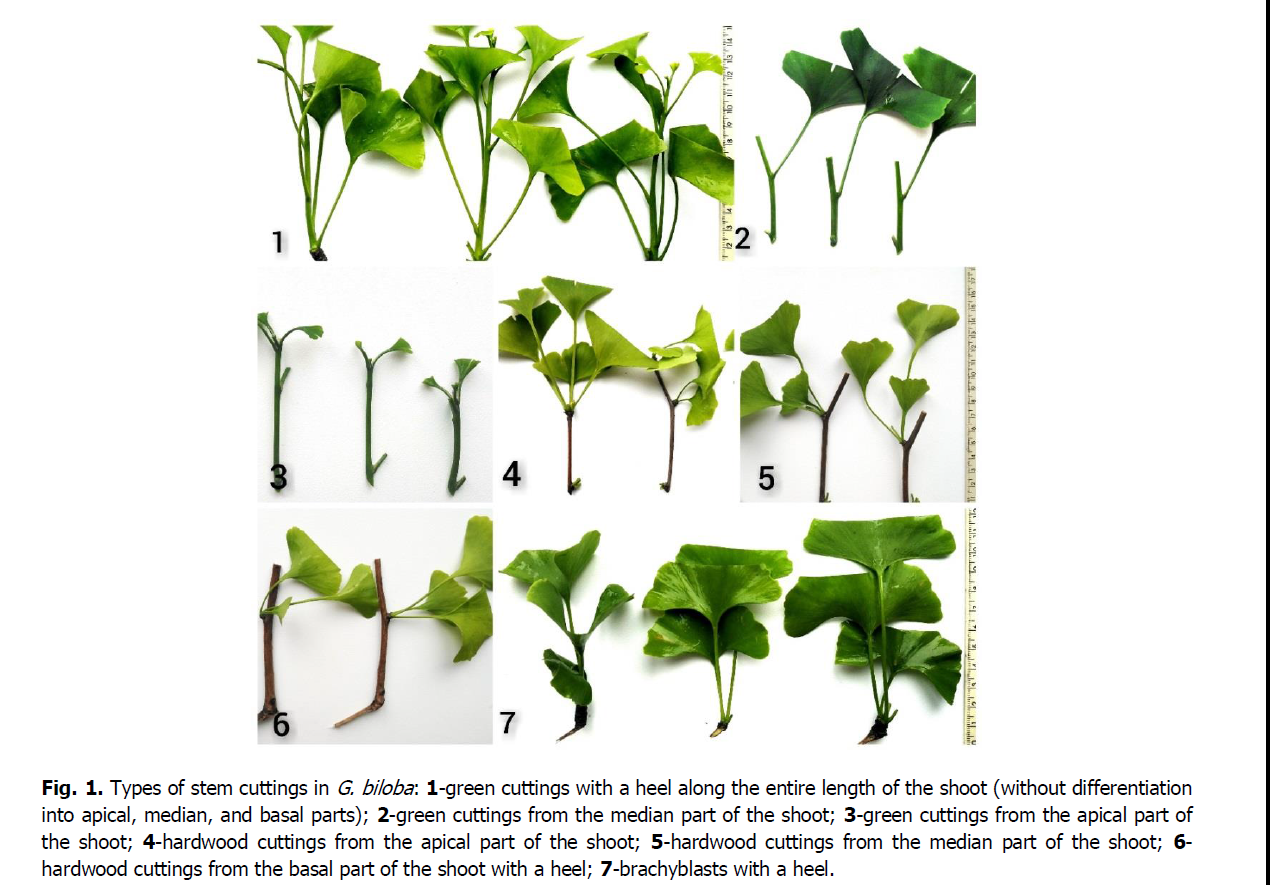
Fig. 1. Types of stem cuttings in G. biloba: 1-green cuttings with a heel along the entire length of the shoot (without differentiation into apical, median, and basal parts); 2-green cuttings from the median part of the shoot; 3-green cuttings from the apical part of the shoot; 4-hardwood cuttings from the apical part of the shoot; 5-hardwood cuttings from the median part of the shoot; 6-hardwood cuttings from the basal part of the shoot with a heel; 7-brachyblasts with a heel.
• Green cuttings of G. biloba with a heel along the entire length of the shoot (without differentiation into apical, median, and basal parts), 12-15 cm long, with 7-8 internodes; two or three lower leaves of the cutting were removed, the remaining leaves were shortened by ½ part, except for the young apical leaves, which were left unchanged.
• Green cuttings of G. biloba from the median part of the shoot, 7-9 cm long, with two internodes; the leaf of the lower internode was removed entirely, and the leaf of the upper internode was shortened by 0.5 parts.
• Green cuttings of G. biloba from the apical part of the shoot, 3-6 cm long, with 2-3 internodes; two leaves of the lower internodes were wholly removed, the remaining upper young apical leaves were left unchanged.
• Hardwood cuttings of G. biloba from the apical part of the shoot, 6-10 cm long, with 2-3 internodes; the leaf near the place of the cut was removed, and the remaining leaves were shortened by ½ part.
• Hardwood cuttings of G. biloba from the median part of the shoot, 7-10 cm long, with two internodes; the leaf near the place of the cut was removed, and the remaining leaves were shortened by ½ part.
• Hardwood cuttings of G. biloba from the basal part of the shoot with a heel, 8-10 cm long, with two internodes; the leaf near the place of the cut was removed, and the remaining leaves were shortened by ½ part.
• Brachyblasts of G. biloba with a heel, 0.5-1.0 cm long; three leaves were removed, and the remaining leaves were shortened by ½ part.
Stem cuttings of cultivars of G. biloba were prepared similarly:
• Semi-hardwood cuttings of G. biloba 'Blagon', 4-8 cm long, with 2-4 internodes, which were selected from the apical, median, and basal (with a heel) parts of the shoot; the leaf near the place of the cut was removed, and the remaining leaves were shortened by ½ part.
• Semi-hardwood cuttings of G. biloba 'Menhir', 2-9 cm long, with 2-4 internodes, which were selected from the apical, median, and basal (with a heel) parts of the shoot; the leaf near the place of the cut was removed, and the remaining leaves were shortened by ½ part.
• Semi-hardwood cuttings of G. biloba 'Tit', 7-10 cm long, with four internodes; heel cuttings were selected along the entire length of the shoot (without differentiation into apical, median, and basal parts); the lower leaves were removed, and the remaining leaves were shortened by ½ part.
• Semi-hardwood cuttings of G. biloba 'Tit', 7-10 cm long, with four internodes; heel cuttings were selected along the entire length of the shoot (without differentiation into apical, median, and basal parts); the lower leaves were removed, and the remaining leaves were shortened by ½ part.
• Hardwood cuttings of G. biloba 'Saratoga' from previous year's shoots, since during the research this cultivar showed no current-year shoot growth; 4-8 cm long cuttings, with 2-3 internodes, were harvested from the apical, median, and basal (with a heel) parts of the shoot; the leaf near the cut was removed, and the remaining leaves were shortened by 0.5 part.
Among all types of rooting stimulants for cuttings of G. biloba and its cultivars that have been tested throughout the study period, the powdered stimulant "HIMAL (AB) Aqua" (indole butyric and naphthaleneacetic acids -0,2%, captan -1% and benzimidazole-2%) proved to be the most effective. Successful rooting of stem cuttings of the plants studied is based on the effect of the aforementioned rooting stimulant.
Having studied methods of vegetative propagation of G. biloba on several diagnostic indicators (Tables 1 and 2) (a type of stem cuttings (7 types), rooting period (day), rooting degree (6-point scale), integrated root index (U, %), rooting percentage (%), plant yield of plants after winter (%), propagation by green stem cutting propagation was singled out as the optimal method of vegetative propagation of G. biloba, consisting of using green heel cuttings along the entire length of the shoot (without differentiation into apical, median and basal parts): rooting period-37-44 days, rooting degree-5 points (cuttings rooted very well), integrated root index (U,%)-80.3-89.6%, rooting percentage-92-96%, plant yield of plants after winter-90-93%.
| S.No. | Type of stem cutting | Date of stem cutting | Rooting | Features of root stem | The yield of plants after winter % | ||
|---|---|---|---|---|---|---|---|
| Period, day | % | A number of roots, pcs. | root length, cm | ||||
| Ginkgobiloba L. | |||||||
| 1. | Green cuttings with a heel along the entire length of the shoot | 30.05 | 37 | 92 | 7.4 ± 0.3 | 6.2 ± 0.2 | 90 |
| 05.06 | 44 | 96 | 6.8 ± 0.2 | 5.4 ± 0.2 | 93 | ||
| 15.06 | 44 | 92 | 6.4 ± 0.2 | 5.0 ± 0.3 | 90 | ||
| 2. | Green cuttings from the median part of the shoot | 30.05 | 50 | 76 | 4.3 ± 0.2 | 3.8 ± 0.3 | 73 |
| 05.06 | 52 | 80 | 3.9 ± 0.3 | 3.5 ± 0.2 | 76 | ||
| 15.06 | 57 | 86 | 3.7 ± 0.3 | 2.8 ± 0.3 | 81 | ||
| 3. | Green cuttings from the apical part of the shoot | 30.05 | 0 | 0 | 0 | 0 | 0 |
| 05.06 | 0 | 0 | 0 | 0 | 0 | ||
| 15.06 | 49 | 58 | 5.4 ± 0.2 | 2.6 ± 0.3 | 51 | ||
| 4. | Hardwood cuttings from the apical part of the shoot | 30.05 | 56 | 96 | 5.8 ± 0.2 | 7.3 ± 0.3 | 93 |
| 5. | Hardwood cuttings from the median part of the shoot | 30.05 | 56 | 82 | 4.2 ± 0.1 | 3.5 ± 0.2 | 78 |
| 6. | Hardwood cuttings from the basal part of the shoot with a heel | 30.05 | 47 | 92 | 4.6 ± 0.1 | 3.8 ± 0.2 | 90 |
| 7. | Brachyblasts with a heel | 30.05 | 43 | 98 | 14.2 ± 0.5 | 4.3 ± 0.1 | 80 |
| G. biloba ‘Blagon’ | |||||||
| 1. | Semi-hardwood cuttings | 22.07 | 54 | 94 | 7.6 ± 0.3 | 5.2 ± 0.4 | 87 |
| G. biloba ‘Menhir’ | |||||||
| 2. | Semi-hardwood cuttings | 22.07 | 54 | 96 | 12.8 ± 0.6 | 3.2 ± 0.1 | 90 |
| G. biloba ‘Tit’ | |||||||
| 3. | Semi-hardwood cuttings | 22.07 | 54 | 92 | 12.4 ± 0.4 | 4.5 ± 0.2 | 86 |
| G. biloba‘Saratoga’ | |||||||
| 4. | Hardwood cuttings | 22.07 | 63 | 96 | 14.3 ± 0.6 | 5.8 ± 0.2 | 84 |
Table 1. Rhizogenic ability of different types of stem cuttings of G. biloba and Cultivars of G. biloba 'Blagon', 'Menhir', 'Tit', 'Saratoga'.
| S.No | Type of Stem Cutting | Date of Stem Cutting | Σn, pcs. | Number of Rooted Cuttings, pcs. | n0=0, pcs. | n1=1, pcs. | n2=2, pcs. | n3=3, pcs. | P, % | Navg | P × Navg | U, % | Rhizogenic Ability, score |
|---|---|---|---|---|---|---|---|---|---|---|---|---|---|
| Ginkgobiloba L. | |||||||||||||
| 1. | Green cuttings with a heel along the entire length of the shoot | 30.05 | 50 | 46 | 4 | 0 | 6 | 40 | 92.0 | 2.64 | 242.9 | 81.0 | 5 |
| 05.06 | 50 | 48 | 2 | 0 | 4 | 44 | 96.0 | 2.80 | 268.8 | 89.6 | 5 | ||
| 15.06 | 50 | 46 | 4 | 0 | 7 | 39 | 92.0 | 2.62 | 241.0 | 80.3 | 4 | ||
| 2. | Green cuttings from the median part of the shoot | 30.05 | 50 | 38 | 12 | 2 | 22 | 14 | 76.0 | 1.76 | 133.8 | 44.6 | 3 |
| 05.06 | 50 | 40 | 10 | 6 | 16 | 18 | 80.0 | 1.84 | 147.2 | 49.1 | 3 | ||
| 15.06 | 50 | 43 | 7 | 2 | 21 | 20 | 86.0 | 2.08 | 178.9 | 59.6 | 3 | ||
| 3. | Green cuttings from the apical part of the shoot | 30.05 | 50 | 0 | 50 | 0 | 0 | 0 | 0 | 0 | 0 | 0 | 0 |
| 05.06 | 50 | 0 | 50 | 0 | 0 | 0 | 0 | 0 | 0 | 0 | 0 | ||
| 15.06 | 50 | 29 | 21 | 11 | 18 | 0 | 58.0 | 0.94 | 54.5 | 18.2 | 1 | ||
| 4. | Hardwood cuttings from the apical part of the shoot | 30.05 | 50 | 48 | 2 | 0 | 12 | 36 | 96.0 | 2.64 | 253.4 | 84.5 | 5 |
| 5. | Hardwood cuttings from the median part of the shoot | 30.05 | 50 | 41 | 9 | 2 | 8 | 31 | 82.0 | 2.22 | 182.0 | 60.7 | 3 |
| 6. | Hardwood cuttings from the basal part of the shoot with a heel | 30.05 | 50 | 46 | 4 | 0 | 2 | 44 | 92.0 | 2.72 | 250.2 | 83.4 | 5 |
| 7. | Brachyblasts with a heel | 30.05 | 50 | 49 | 1 | 0 | 0 | 49 | 98.0 | 2.94 | 288.1 | 96.0 | 5 |
| G. biloba 'Blagon' | |||||||||||||
| 8. | Semi-hardwood cuttings | 22.07 | 50 | 47 | 3 | 0 | 3 | 44 | 94.0 | 2.76 | 259.4 | 86.5 | 5 |
| G. biloba 'Menhir' | |||||||||||||
| 9. | Semi-hardwood cuttings | 22.07 | 50 | 48 | 2 | 0 | 2 | 46 | 96.0 | 2.84 | 272.6 | 90.9 | 5 |
| G. biloba 'Tit' | |||||||||||||
| 10. | Semi-hardwood cuttings | 22.07 | 50 | 46 | 4 | 0 | 1 | 45 | 92.0 | 2.74 | 252.1 | 84.0 | 5 |
| G. biloba 'Saratoga' | |||||||||||||
| 11. | Hardwood cuttings | 22.07 | 50 | 48 | 2 | 0 | 3 | 45 | 96.0 | 2.82 | 270.7 | 90.2 | 5 |
Table 2. Quantitative and integrated root indexes of different types of stem cuttings of G. biloba and Cultivars of G. Biloba 'Blagon', 'Menhir', 'Saratoga', 'Tit'.
Results and Discussion
The highest number of roots (12.4-14.3 pieces) was observed in stem cuttings selected from short shoots (brachyblasts) with a heel of G. biloba, as well as from semi-hardwood and hardwood shoots of G. biloba 'Tit', G. biloba 'Menhir', G. biloba ‘Saratoga.’ The smallest number of roots (3.7-4.6 pieces) was discovered in green stem cuttings from the median part of the shoot, hardwood cuttings from the median, and basal (with a heel) parts.
The maximum length of roots (6.2-7.3 cm) was observed in green heel cuttings along the entire length of the shoot of G. biloba and hardwood cuttings from the apical part of the shoot of G. biloba. Minimum root length (2.6-2.8 cm) was detected in green cuttings from the apical and median parts of the G. biloba shoot.
The cuttings of G. biloba selected from short shoots (brachyblasts) with a heel proved to have a high rooting degree (5 points), the integrated index of which (U, %) is 96%, and the maximum number of roots (14,2 ± 0,5 pieces). The rooting period of these cuttings was the shortest-43 days (Tables 1 and 2). The rooted brachyblastic cuttings of G. Biloba are to be further monitored, as this method of vegetative propagation has the potential for getting low-growing G. biloba plants with dense bush-shaped crowns, as well as their garden forms.
Having performed the calculations of the rhizogenic ability of seven types of G. biloba (Table 2), it was determined that all types of G. biloba heel cuttings of G. Bilobas take root well and very well.
The most favorable time to harvest green stem cuttings of G. biloba from the apical part of the shoot is mid-June and July, as propagation in the early period (May and early June) leads to rotting of the cuttings and their total failure.
By transplanting green and hardwood root cuttings of G. biloba, propagated in late May-early June, into containers for growing (mid-October), they were characterized by a well-developed root system with many first-order lateral roots. At the same time, semi-hardwood-rooted cuttings from G. biloba were characterized by a well-developed root system with no first-order lateral roots, which, in our opinion, was due to a later period of propagation (mid-July). It should be noted that the absence of branches on the roots of G. biloba cultivars when transplanting them into containers for growth does not affect the further development of plants (Figs 2 and 3).
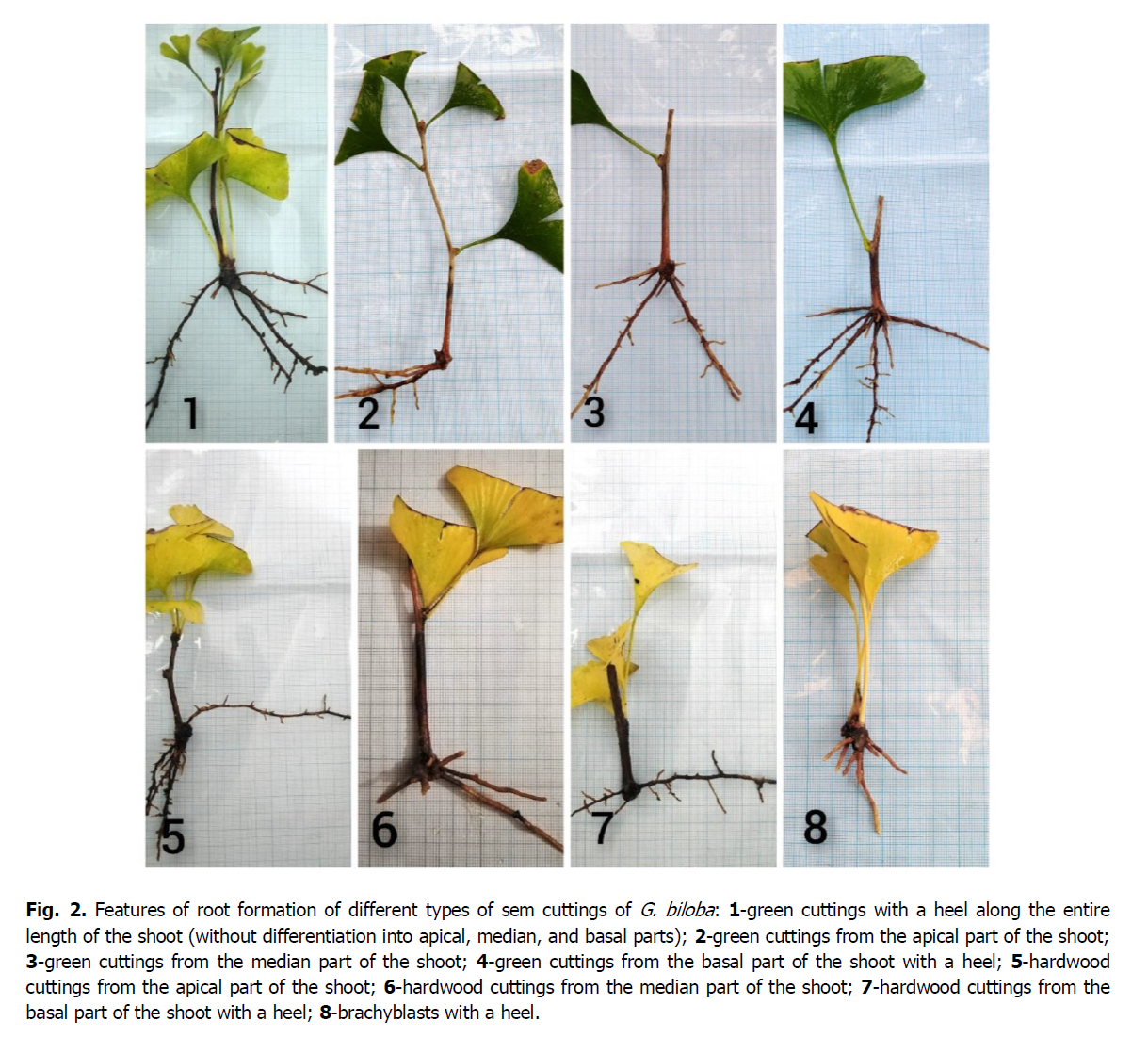
Fig. 2. Features of root formation of different types of sem cuttings of G. biloba: 1-green cuttings with a heel along the entire length of the shoot (without differentiation into apical, median, and basal parts); 2-green cuttings from the apical part of the shoot; 3-green cuttings from the median part of the shoot; 4-green cuttings from the basal part of the shoot with a heel; 5-hardwood cuttings from the apical part of the shoot; 6-hardwood cuttings from the median part of the shoot; 7-hardwood cuttings from the basal part of the shoot with a heel; 8-brachyblasts with a heel.
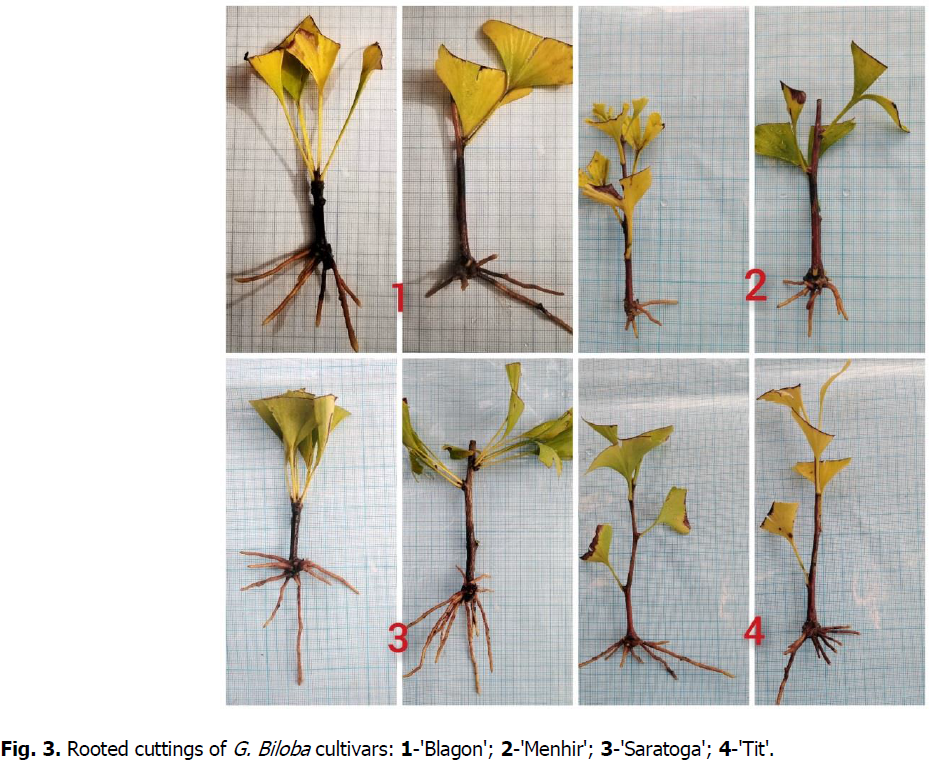
Fig. 3. Rooted cuttings of G. Biloba cultivars: 1-'Blagon'; 2-'Menhir'; 3-'Saratoga'; 4-'Tit'.
All the cultivars studied, G. biloba 'Blagon', G. biloba 'Menhir', G. biloba 'Saratoga' and G. biloba 'Tit', were characterized by an excellent rooting degree (5 points), the integrated index of which (U, %) is 84.0-90.9%, the rooting percentage-92-96%, the yield of plants after winter-84-90%. The highest number of roots (14.3 ± 0.6 pieces) with the maximum length (5.8 ± 0.2 cm) were formed in rooted cuttings of G. biloba' Saratoga', propagated by hardwood cuttings in mid-July (Fig. 3).
The reason for the long rooting period of cuttings of cultivars of G. biloba (54-63 days) is the late period of propagation (mid-July).
We determined that when preparing different types of cuttings of G. biloba for vegetative propagation by stem cuttings, removing part of the leaves on selected cuttings is necessary.
In auxiblasts the leaf at the cutting base needs to be removed entirely; in brachyblasts, half of the leaves need to be removed; the remaining leaves should be left unchanged, or shortened by ½ part. We also identified that the shortening of the leaf blade of G. biloba cuttings does not affect the rooting degree of cuttings; that is, the leaves can be used without shortening, but their number should be reduced (Fig. 4).
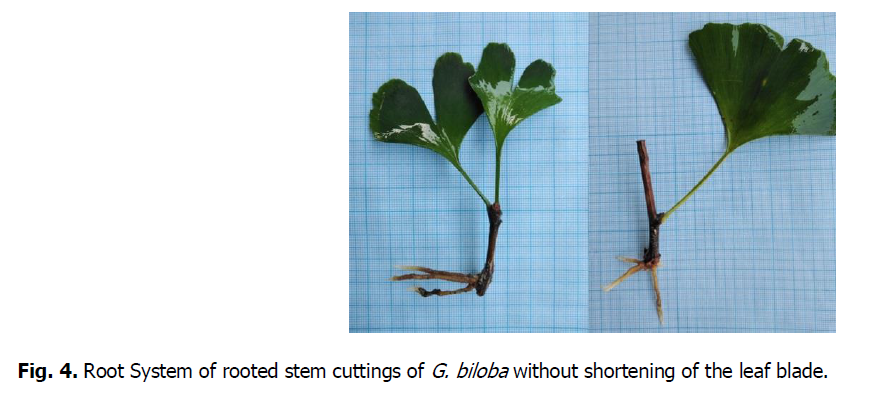
Fig. 4. Root System of rooted stem cuttings of G. biloba without shortening of the leaf blade.
Having studied the dynamics of callus formation and the appearance of roots on the stem cuttings of G. biloba and its cultivars, it was concluded that the emergence of callus is observed 20-25 days after propagation, and the emergence of the first roots-24-30 days after callus formation. The roots of G. biloba are formed radially in the basal part of the cutting. When using heel cutting, the roots are located radially along the perimeter of the heel (Fig. 5).
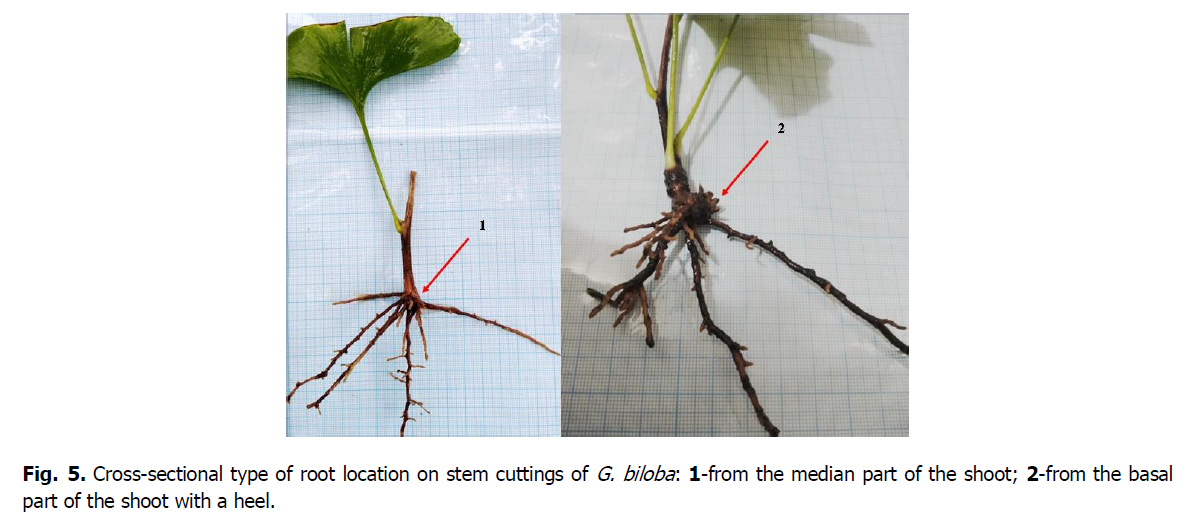
Fig. 5. Cross-sectional type of root location on stem cuttings of G. biloba: 1-from the median part of the shoot; 2-from the basal part of the shoot with a heel.
Transplantation of stem cuttings of G. biloba and its cultivars from the greenhouse into containers was performed on October 25, 2020. Containers with transplanted plants were first transferred to a greenhouse, then, for the winter, to the basement with an air temperature not lower than+5ºC (Fig. 6). For the spring, they have moved to the greenhouse again.
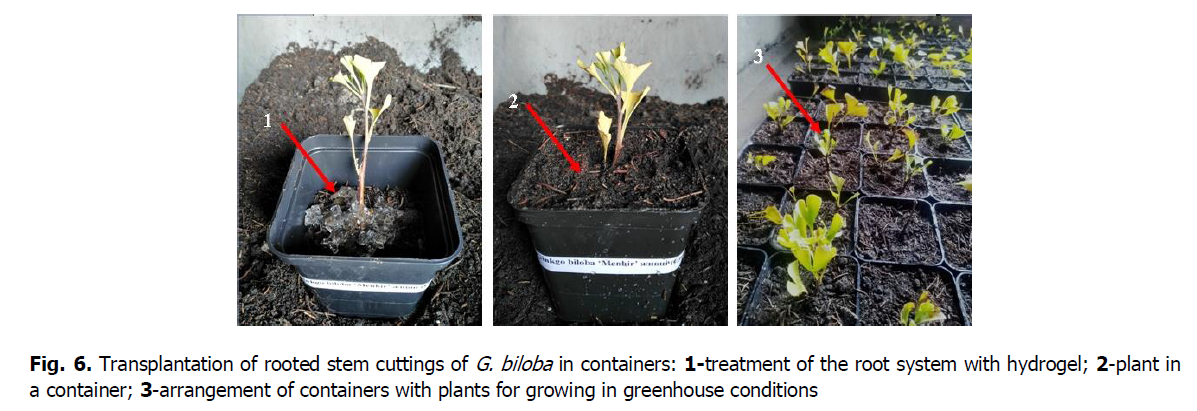
Fig. 6. Transplantation of rooted stem cuttings of G. biloba in containers: 1-treatment of the root system with hydrogel; 2-plant in a container; 3-arrangement of containers with plants for growing in greenhouse conditions
In March and April, after transferring the plants to the greenhouse. After transferring the plants to the greenhouse in March and April, the soil surface was loosened and finely watered once in 1.5-2 weeks. Owing to the moisturizing effect of the hydrogel, the plants did not need care in the autumn and winter periods. After winter, the yield of rooted plants was identified in mid-April 2021, based on the results of counting plants, in which the phase of leafing was observed (Fig. 7).

Fig. 7. G. biloba after winter (mid-April, 2021): 1-G. biloba (from auxiblasts); 2-G. biloba 'Saratoga'; 3-G. biloba' Menhir'; 4-G. biloba (from brachyblasts); 5-G. biloba ‘Tit’; 6-G. biloba ‘Blagon’.
The buds of G. biloba 'Saratoga' and G. biloba 'Menhir' were the first to bloom (mid-March). The rest of the cultivars and plants of the species were characterized by almost identical bursts of vegetative buds after dormancy (late March).
Conclusion
In the research, a new digital method of evaluation and identification of the optimal variant of vegetative propagation of G. biloba was tested in a comprehensive study on several indicators. The indicators included a type of stem cutting (7 types), rooting period (day), rooting degree (6-point scale), integrated root index (U, %), rooting percentage (%), and the yield of plants after winter (%). Green stem cuttings were selected as the optimal method of vegetative propagation of G. biloba, consisting of used green heel cuttings along the entire length of the shoot (without differentiation into the apical, median and basal parts). The findings were based on some diagnostic indicators: rooting period-37-44 days, rooting degree-5 points (cuttings rooted very well), integrated root index (U, %)-80.3-89.6%, rooting percentage-92-96%, yield of plants after winter-90-93%. We found that the root formation of stem cuttings of G. biloba does not depend on the age of the plant, the length of cuttings, and the number of internodes. When preparing different types of G. biloba for vegetative propagation by stem cuttings, it is unnecessary to shorten the leaf blade by 1/2 parts, but the number of leaves must be reduced.
The presence or absence of first-order lateral roots on the stem cuttings of G. biloba, while transplanting them into containers for does not affect the future development of plants and their wintering. The emergence of the callus was concluded that the emergence of callus is observed to occur 20-25 days after propagation and the emergence of the first roots 24-30 days after callus formation. The cross-sectional type of root formation is characteristic of G. Biloba cuttings. The roots of G. biloba are formed radially in the basal part of the cutting. When using heel cutting, the roots are located radially along the perimeter of the heel. Methods of vegetative propagation of G. biloba, using different types of semihardwood cuttings of G. biloba 'Blagon', G. biloba 'Menhir', G. biloba ‘Tit’, and hardwood cuttings of G. biloba 'Saratoga', were evaluated. The assessment involved several diagnostic indicators: rooting period-54-63 days, rooting degree-5 points (cuttings rooted very well), integrated root index (U, %)-84.0-90.9%, rooting percentage-92-96 %, and yield of plants after winter-84-90%. Cuttings of G. biloba and its cultivars are characterized by high regenerative capacity over a long period of propagation (May-July), as well as a high percentage of rooting-from 80 to 98%, except for green cuttings from the median part of the shoot, selected in late May (76%), and green cuttings from the apical part of the shoot, selected in mid-June (58%). According to the 6-point root scale of stem cuttings, all types of heel cuttings of G. biloba proved to take root well and very well.
References
Aleksandrova, M.S., Bulygin, N.E., Voroshilov, V.N. (1975). Metodika fenologicheskikh nabliudeniy v botanicheskikh sadakh SSSR. Moskcow: Nauka (in Russian).
Bilyk, E.V. (1993). Razmnozhenie drevesnykh rasteniy steblevymi cherenkami i privivkoy: Monografiia. Kiev: Naukova dumka (in Russian).
Glukhov, A.Z., Dovbysh, N.F., Kharkhota, L.V. (2008). Accelerated vegetative propagation of Ginkgo biloba L. in South-East Ukraine. Bulletin Nikit Botany Gard, 96:35-37 (in Ukrainian).
Guz, M.M., Hrechanyk, R.M., Ostudimov A.O. (2008). Peculiarities of reproduction of maidenhair tree in vitro. Naukovyy visnyk NLTU Ukrainy, 18:7-16 (in Ukrainian).
Derev'ia i kustarniki SSSR: dikorastushchie, kul'tiviruemye i perspektivnye dlia introduktsii. Golosemennye. (1949). T.І. Moscow, Leningrad: Akademiya Nauk SSSR (in Russian).
Ivanova, Z.Ia. (1982). Biologicheskie osnovy i priemy vegetativnogo razmnozheniia drevesnykh rasteniy steblevymi cherenkami. Kiev: Nauk. Dumka (in Russian).
Ivaniuk, I.V., Zavads'ka, M.O. (2013). Vplyv stymuliatoriv rostu na skhozhist' nasinnia ta ukorinennia zhyvtsiv hinkho dvolopatevoho (Ginkgo biloba L.). Naukovyy visnyk Natsional'noho universytetu bioresursiv i pryrodokorystuvannia Ukrainy. Ser.: Lisivnytstvo ta Dekoratyvne Sadivnytstvo, 187:147-152.
Ivaniuk, T.M., Kotiuk, L.A., Krasevych, N.O., Mykhaylovs'kyy, L.V., Trofymenko, P.I. (2013). Botanichnyy sad Zhytomyrs'koho natsional'noho ahroekolohichnoho universytetu: inform.-dovid. Putivnyk. Zhytomyr: Zhytomyrs'kyy Natsional'nyy Ahroekolohichnyy Universytet, pp:149-150 (in Ukrainian).
Karashchuk, O.A., Rogachev, Iu. B., Efimenko, A.A. (2019). Introduktsiia Ginkgo biloba L. v botanicheskom sadu 1-go MGMU im. I. Sechenova, M. Novosti nauki v APK (Severo-Kavkazskiy federal'nyy nauchnyy agrarnyy tsentr). Stavropol', 1:67-71 (in Russian).
Malankina, E. (2001). Ginkgo dvulopastnyy. Tsvetovodstvo, 2:39 (in Russian).
Meleshko, H.I., Meleshko, V.V. (2009). Stymuliatsiia ryzohenezu u steblovykh zhyvtsiv predstavnykiv rodyny Magnoliaceae Juss. Introduktsiia, selektsiia ta zakhyst roslyn: Materialy Druhoi mizhnarodnoi naukovoi konferentsii, 6-8 zhovtnia. Donets'k, 2:88-91 (in Ukrainian).
Metodychni rekomendatsii z rozmnozhennia derevnykh dekoratyvnykh roslyn Botanichnoho sadu NUBiP Ukrainy. (2008). Kiev: Vyd. tsentr NUBiP Ukrainy (in Ukrainian).
Molchanov, A.A., Smirnov, V.V. (1967). Metodika izucheniia prirosta drevesnykh rasteniy. Moscow: Nauka (in Russian).
Nechytaylo, V.A., Kucheriava, L.F., Botanika, K. (2000). Vyshchi roslyny. Kyiv: Fitosotsiotsentr (in Ukrainian).
Nikitinskiy, Iu.I. (1981). Razmnozhenie dekorativnykh derev'ev i kustarnikov zelenymi cherenkami. Uchebnoe posobie dlia studentov. Leningrad: LTA (in Russian).
Ostudimov A.O., Guz, M.M. (2010). Peculiarities of Ginkgo biloba seed reproducnion. Naukovyy visnyk NLTU Ukrainy, 20:8-16 (in Ukrainian).
Rekomendatsii po zastosuvanniu rehuliatora rostu roslyn Charkoru dlia rozmnozhennia iahidnykh, plodovykh ta dekoratyvnykh kul'tur. Natsional'na akademiia nauk Ukrainy. (2002). Kyiv (in Ukrainian).
Samorodov, V.N., Pospelova, A.D. (2016). Medicinal Herbs: from Past Experience to New Technologies. Proceedings of Fifth International Scientific and Practical Internet Conference. Poltava (in Russian).
Tereshchuk, A.I. (2009). Hinkho-tsilytel'. Ukrains'ki narodni zvychai. Vydannia 2-he, dop. ta pereroblene. Kyiv: Lohos Ukrainy (in Ukrainian).
Torchik, V.I., Kholopuk, G.A., Kel'ko, A.F. (2018). Perspektivy introduktsii ginkgo dvulopastnogo (Ginkgo biloba L.) v Belarusi. Vestsі Natsyianal'nay akademіі navuk Belarusі. Seryia bіialagіchnykh navuk, 63:27-32.
Woody plants of the Main Botanical Garden named after N.V. Tsitsin of the Russian Academy of Sciences. (2005). Moscow: Nauka (in Russian).
Zagumennikova, T.N, Burova, A.E., Budarin, S.N. (2016). The issue of seed and vegetative propagation of Ginkgo biloba L. in the conditions of Moscow region. Moscow: Shcherbinskaia Tipografiia (in Russian).
Author Info
І.S. Kosenko, N.V. Tsybrovska*, O.A. Balabak, V.М. Hrabovyi, H.І. Muzyka, Т.А. Shvets and V.М. ОksantiukCitation: Kosenko, ?.S., Tsybrovska, N.V., Balabak, ?.?., Hrabovyi, V.?., Muzyka, H.?., Shvets, ?.?., ?ksantiuk, V.?. (2021). Introduction of Ginkgo biloba L. and its cultivars by vegetative propagation. Ukrainian Journal of Ecology, 11 (7), 65-76.
Received: 02-Aug-2021 Accepted: 16-Sep-2021 Published: 27-Sep-2021
Copyright: This is an open access article distributed under the terms of the Creative Commons Attribution License, which permits unrestricted use, distribution, and reproduction in any medium, provided the original work is properly cited.
